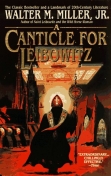BKMT READING GUIDES
A Canticle for Leibowitz (Bantam Spectra Book)
by Walter M. Miller Jr.
Paperback : 368 pages
0 club reading this now
0 members have read this book
In the Utah desert, Brother Francis ...
Introduction
(In celebration of the publication of the sequel Saint Leibowitz and the Wild Horse Woman comes this special edition of the classic A Canticle for Leibowitz, a novel that transcends genre to stand as one of the most significant literary works of our time.
In the Utah desert, Brother Francis of the Albertian Order of Leibowitz has made a miraculous discovery: the relics of the martyr Isaac Leibowitz himself, including the blessed blueprint and the sacred shopping list. They may provide a bright ray of hope in a terrifying age of darkness, a time of ignorance and genetic monsters that are the unholy aftermath of the Flame Deluge. But as the spellbinding mystery at the core of this extraordinary novel unfolds, it is the search itself--for meaning, for truth, for love--that offers hope to a humanity teetering on the edge of an abyss.
A timeless and still timely masterpiece, A Canticle for Leibowitz is a classic that ranks with Brave New World and 1984.
Walter M. Miller's acclaimed SF classic A Canticle for Leibowitz opens with the accidental excavation of a holy artifact: a creased, brittle memo scrawled by the hand of the blessed Saint Leibowitz, that reads: "Pound pastrami, can kraut, six bagels--bring home for Emma." To the Brothers of Saint Leibowitz, this sacred shopping list penned by an obscure, 20th-century engineer is a symbol of hope from the distant past, from before the Simplification, the fiery atomic holocaust that plunged the earth into darkness and ignorance. As 1984 cautioned against Stalinism, so 1959's A Canticle for Leibowitz warns of the threat and implications of nuclear annihilation. Following a cloister of monks in their Utah abbey over some six or seven hundred years, the funny but bleak Canticle tackles the sociological and religious implications of the cyclical rise and fall of civilization, questioning whether humanity can hope for more than repeating its own history. Divided into three sections--Fiat Homo (Let There Be Man), Fiat Lux (Let There Be Light), and Fiat Voluntas Tua (Thy Will Be Done)--Canticle is steeped in Catholicism and Latin, exploring the fascinating, seemingly capricious process of how and why a person is canonized. --Paul Hughes
Discussion Questions
No discussion questions at this time.Book Club Recommendations
Recommended to book clubs by 0 of 0 members.
Book Club HQ to over 90,000+ book clubs and ready to welcome yours.
Get free weekly updates on top club picks, book giveaways, author events and more








